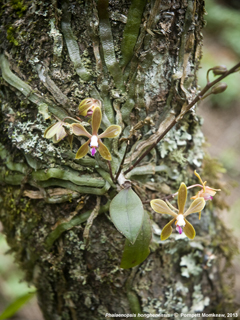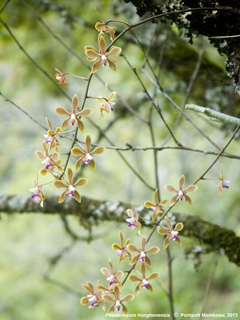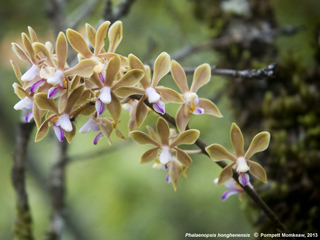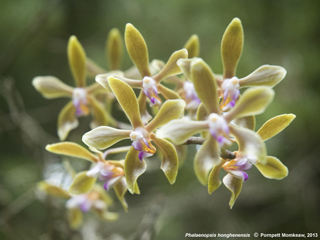| Phalaenopsis
honghenensis F.Y. Liu, in situ |
| |
| |
|
Phalaenopsis
honghenensis F.Y. Liu, was
discovered in north of Thailand at Doi Angkhang, 300 Km North of Chiang
Mai. It is here, in a mountainous area near the border with Burma that
in June 2012, Mr. Pornpett Momkeaw was very fortunate to discover, in
full bloom, plants of Phalaenopsis honghenensis, thus
discovering for
the first time this plant in Thailand.
This species is often grown as Phalaenopsis braceana. In an
article
published in 2010 Stig Dalstrom, Ngawang Gyeltshen and Thomas H÷ijer
establish that Phalaenopsis braceana is synonymous with Phalaenopsis
taenialis so this name should not be used. In another article
published later in 2010, Stig Dalstrom and Paul Ormerod establish that
plants grown and improperly named as Phalaenopsis braceana
correspond to a
species described by Professor Liu in 1991. At that date, from a plant
collected in the Yunnan province of China, Professor Liu described a new
Phalaenopsis species and named it Phalaenopsis honghenensis.
|
| |
|
 |
The plants are in full bloom in
June. They are growing as epiphytes on trees
with mossy trunks and are protected from direct sunlight by the foliage
of host trees. The flower stems are growing far from the trunks,
highlighting the flowers.
|
| |
|
 |
 |
| The plants have many flat roots that hang the
plant firmly to its host. Few leaves are present during flowering. |
The flowers are conspicuous. Note the thick
layer of mosses and lichens growing on the branches near the plants.
The fourth flower of the floral stem at the top has a different
coloration and appears to be a flower having been fertilized and
beginning to develop a capsule.
|
| |
|
 |
 |
| Click on the photo to enlarge it and note the
flatter shape of the lip of this plant. Also notice the
caterpillar which lies between two flowers. Its color is very close to
the color of the flowers and both ends are black. |
Note
the prominent spur on the flower view by side located in the center of
the photo, as well as on the last flower starting to open. Note that
the spur is already visible on the last two buttons still closed.
|
| |
|
 |
| Click on the photos to enlarge them. |
| |





